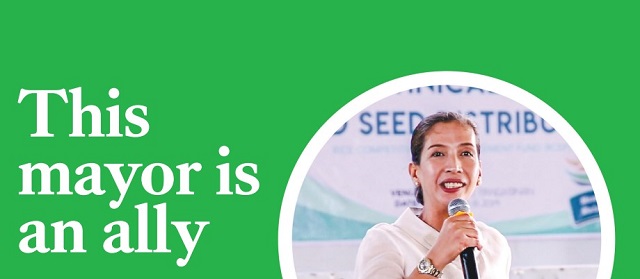
Consider farming a business enterprise – this has been PhilRice’s “gospel” to Filipino farmers. The Institute believes that they can help the country compete with neighboring nations if they produce more, lessen their production cost, and sell their produce at a competitive price. This can be accomplished with the help of local government units and other partner-entities.
One of PhilRice’s allies is Maria Theressa Rodriguez-Peralta, the first lady mayor of Balungao, Pangasinan in 200 years. The public servant and economist shares her thoughts on her administration’s programs and how the LGU of Balungao helps farmers become competitive.
Can you tell us what led you to become a public servant and Mayor of Balungao?
My husband and in-laws influenced me to be a public servant. I decided to run in 2019 to continue what my husband had started. Before I became mayor, I used to volunteer for Red Cross and some charitable institutions. I was also busy taking care of our businesses on construction, trucking, equipment rental, school, testing center, and rice farming.
Working on the ground, I’ve realized that I could do more if I serve in the local government. I wanted to help, especially the rice farmers. I wanted them to earn more since they are the ones who feed us.
What agri programs have you implemented in your municipality so far?
To end up big, you need to start with small steps. To help lessen the cost in farming, we’ve offered free trucking services. I even allow our personal trucks to be used by my fellow Balungao farmers. All they have to do is to let us know when they will need the trucks so that we can have them scheduled. No charges, not even for gasoline.
We’ve also supported the development of a small water-impounding project so that our farmers can have adequate water supply to irrigate their farmlands.
In addition, we fully support the implementation of the Rice Competitiveness Enhancement Fund (RCEF) programs in Balungao. We’ve developed a mechanism for ease of certified seed distribution. Before the distribution, we went to different barangays and had our farmers listed in the Registry System for Basic Sectors in Agriculture to ensure that they will all avail of the free seeds.
We have also come up with an information campaign explaining to the farmers the objectives of rice tariffication and the importance of valuing government grants in order to make them more competitive through RCEF. Regular seminars are offered by the municipal agriculture office.
How do you plan to help achieve the goals of the DA in the rice industry and lead Balungao farmers into being more competitive?
The most difficult part was arresting the threat that farmers will just sell their farmlands.
We will let farmers realize that farming is business. Let us teach them how to compute their expenses so that they will know how to deal with traders. In fact, we give our farmers daily price advisories so they can bargain better with traders.
With regard to technology promotion, I believe that there is no single scientific way on how to approach our farmers. What is important is we let them feel how much we value them through constant dialogue. We can’t impose on them what to do but we can give them options on how to increase their yield, lessen their production cost, and sell their produce at a competitive price.
What will you do to help Balungao farmers become competitive under rice tariffication?
First, we let them understand what’s rice tariffication and why we need to implement it. It’s like explaining to them why there is Jollibee even if there are local food places in the community. If farmers will recognize the need to compete with imported rice then they will strive to make their produce stand out from all the rest.
Also, we are strengthening the literacy program here in Balungao especially in the field of agriculture. If we come to think of it, the future of agriculture is a fully mechanized farm. Before this happens, our farmers should be prepared for it.
What do you think are the roles of local government units in terms of helping farmers approximate the competition?
Let our farmers feel that they can count on us! This is the perfect time to let them know that we are doing our best to help them become successful agri-preneurs. Let us give them the technical know-how’s of farming and put value in what they do.
We expand the economic opportunities of our farmers here by teaming up with the DOLE, DTI, and DA of course.
While waiting for the palay harvest, we can initiate livelihood programs for farmers such as cosmetology, haircutting, or small business like negosyo carts. We are also coordinating with the DSWD to beef-up the pantawid program of our government through the procurement of rice.
Let us connect the dots on how we can better serve our farmers.
What lessons or tips can you offer to your fellow local government officials on helping our farmers?
I am sure that my fellow officials have their own strategies. It would be best if we learn to share because their strategies might work for others as well. Let us remember that no matter how small our ideas are, they could actually portray the bigger picture.
Let our farmers realize that the national government is here to support them. Whatever tax that the government is getting either from Filipinos or imported rice will also benefit the farmers through programs.




